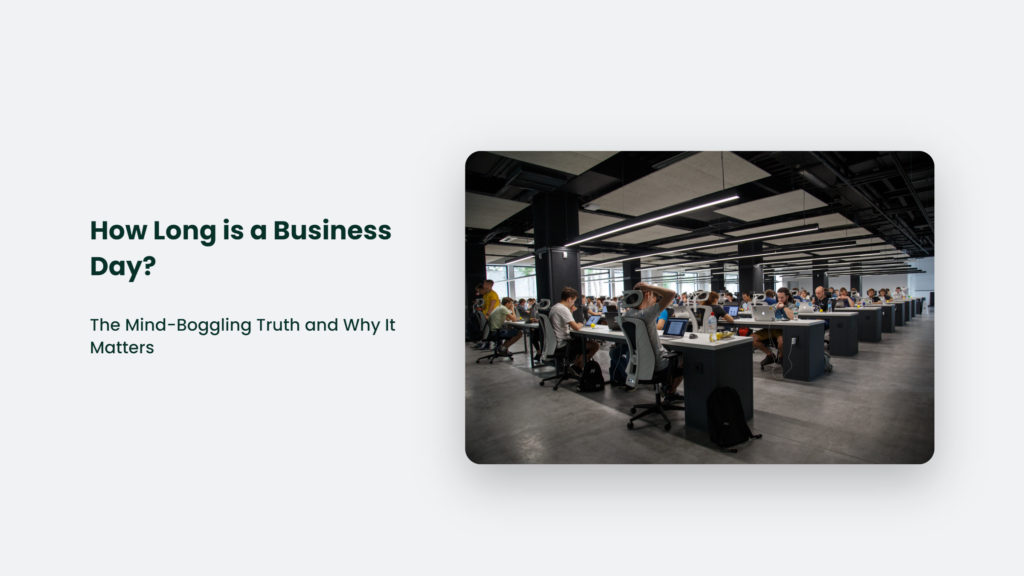Let’s talk about the elephant in the room, shall we? How long is a business day? Before you roll your eyes and mutter, “Duh, eight hours!” let me tell you, dear reader, that’s just the tip of the iceberg. Buckle up because we’re about to embark on a wild ride through the chaos of the modern business day.

Anecdote: The Good Old Days
Remember when we thought a business day was as simple as a 9-to-5 gig? The world was a simpler place, and so were the working hours. But as we hurtle into the glorious age of technology, the lines between work and life are blurring faster than you can say, “TGIF!”
Behold the Work-Life-Blending Paradox
As technology has evolved, so too has the definition of a business day. Gone are the days when you could clock out and leave work behind. In this age of hyper-connectivity, the business day is as elusive as a chameleon, constantly shifting to match the pace of our ever-changing lives.
Let’s Break it Down: The Different Types of Business Days
The Standard 9-to-5: A Familiar Favorite
Ah, the classic 9-to-5. A time-honoured tradition that still holds for many businesses. This Monday to Friday, the 8-hour workday has long been the backbone of the global workforce. Built on the “eight-hour movement,” which advocated for a balance of eight hours of work, eight hours of recreation, and eight hours of rest, this structure has been the norm for decades.
However, as our work culture evolves, it’s becoming clear that the standard 9-to-5 may not be suitable for everyone. Some employees thrive in a traditional work environment, while others may struggle with a rigid schedule. It has led to the rise of alternative work arrangements.
The Flex Day: The Customizable Workday
Some organizations have embraced flexible work hours to accommodate employees’ needs and preferences. This approach allows workers to choose their start and end times, with the understanding that they’ll complete their required tasks and hours within a specific time frame. So, you might work from 7 am to 3 pm, or maybe 12 pm to 8 pm – as long as you finish the job! Enter the Flex Day.
The benefits of Flex Day are manifold. For one, it allows employees to better manage their work-life balance, reducing stress and increasing overall satisfaction. It also enables businesses to accommodate workers in different time zones, particularly useful for remote teams and global companies.
Of course, Flex Day isn’t without its challenges. Managers may need to adjust their expectations and communication styles to accommodate varying schedules, and employees must be disciplined and accountable for their productivity.
The Gig Economy Day: The Wild Card Workday
The rise of the gig economy has brought an entirely new type of workday: the freelancer’s workday. TIt his is where hours can range from a couple of hours a week to 14-hour days, depending on the nature of the work and the individual’s preferences. It’s a brave new world where project-based tasks and deadlines replace traditional work schedules. Gig Economy Day is characterized by flexibility and freedom.
Freelancers can choose when, where, and how they work, making it an attractive option for those seeking autonomy and work-life balance. However, this freedom comes with a unique set of challenges. Gig workers must manage their time, stay disciplined, and juggle multiple clients and projects.
Additionally, the gig economy often lacks the stability and benefits associated with traditional employment, such as health insurance and retirement plans. This trade-off is worth it; for others, it may be a deal-breaker.
Data and Statistics: The Evolution of the Business Day
- According to the Bureau of Labor Statistics, the average American workweek was 34.4 hours in 2020. But that number can be deceiving, as it includes part-time workers and those in the gig economy.
- A study by the Organization for Economic Cooperation and Development found that the average workweek in the United States was 34.3 hours in 2019, down from 38.2 hours in 2000.
Hypothetical Question: What if We Could Reimagine the Business Day?
Imagine a world where the business day was tailored to our individual needs – where work hours were flexible, commutes were a thing of the past, and we could find a balance between our professional and personal lives. Sounds like a utopia, right? Maybe, but it’s not as far-fetched as you might think.

The Benefits of Redefining the Business Day
Improved Work-Life Balance: Breaking Free from the Shackles
One of the most significant advantages of redefining the business day is the potential for a vastly improved work-life balance. Flexible work hours allow employees to better accommodate personal appointments, child care, and other life responsibilities without compromising their professional commitments.
When we’re not bound to a rigid work schedule, we can more easily find time for family, friends, and hobbies – the things that make life truly fulfilling.
For example, a parent may choose to work from 6 am to 2 pm, allowing them to pick up their child from school and spend quality time together in the afternoon. Or, an employee passionate about painting could work from 10 am to 6 pm, providing ample morning hours to indulge their creativity.
Increased Productivity: Unlocking the Power of Flexibility
It may seem counterintuitive, but research has shown that flexible work hours can increase productivity and job satisfaction. When employees are given the autonomy to choose their work hours, they can align their schedules with their natural energy and focus levels, leading to improved performance.
For instance, a night owl may struggle to be productive during traditional office hours, but when allowed to work from 12 pm to 8 pm, they can harness their most productive hours in the evening. Moreover, when employees feel trusted and valued, they are more likely to be engaged and committed to their work, further boosting productivity.
Better Health: The Ripple Effect of Flexibility
The impact of long hours at the office on our mental and physical health is well-documented. Chronic stress, burnout, and a sedentary lifestyle can lead to a myriad of health issues, including heart disease, obesity, and depression. We can reduce stress and improve our overall well-being by redefining the business day and embracing shorter or more flexible workdays.
For example, employees who work from 7 am to 3 pm might use their extra afternoon hours to hit the gym or go for a walk, promoting better physical health. Similarly, allowing remote work options can eliminate lengthy commutes, which can contribute to stress and burnout.
The benefits extend beyond just the individual employee – a healthier workforce can lead to lower healthcare costs and absenteeism for the company as a whole.
Frequently Asked Questions:
How can I make my business day more flexible?
Consider implementing remote work policies, offering flexible hours, or even adopting a results-based work environment.
Are there any drawbacks to redefining the business day?
Some potential drawbacks include difficulty managing employees, a possible decrease in team collaboration, and workers’ potential misuse of flexibility.
What does the future of the business day look like?
While it’s impossible to predict exactly what the future holds, it’s likely that we’ll see an increased emphasis on flexibility, technology-driven work environments, and a greater focus on work-life balance.
In Conclusion: How long is a business day?
The question “How long is a business day?” may never have a definitive answer again. As we hurtle into the future, the very concept of a business day will continue to evolve, shaped by technology, the gig economy, and our ever-changing lives. Instead of resisting this chaotic transformation, let’s embrace it – and perhaps we’ll find a better way to work and live in the process.




